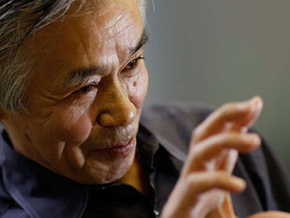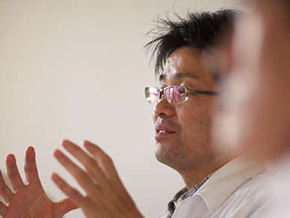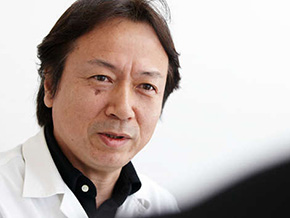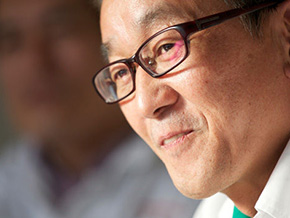Motorcycles Technology
CBR1000RR - History : Episode01
Lightweight design that transcends the spec sheet
Lightweight design that transcends the spec sheet
In 1992, Honda launched the CBR900RR, making a step change from the engine power and displacement supremacism that dominated the super sport bikes scene, and allowing every rider to enjoy total control. Believing that customers would shy away from a bike that was neither 750cc nor 1,000cc, Honda affiliates in Europe first sold the new model as the “FireBlade” without a displacement figure. In time, however, even Europe embraced the name “CBR900RR,” signaling that a new way of understanding and valuing super sport bikes was spreading across the globe. In 2000, the fifth-generation CBR900RR (CBR929RR) further refined the vision of the first-generation model. Virtually all of its structural elements reflected a new and advanced technological approach, including its new higher-displacement engine, which was the first in the series to incorporate a fuel injection system.

Fifth-generation 2000 CBR900RR (CBR929RR)

Taking lightweight and compact design to the next level
Former Honda Racing Corporation (HRC) works rider Hikaru Miyagi: The first-generation CBR900RR really rocked the world with its lightweight and compact design. Yet, in subsequent model changes over the years, it got even more powerful and lightweight.
Seventh-generation CBR1000RR development team leader Hirofumi Fukunaga: In the third generation, we made the exhaust pipe stainless steel and eliminated the fuel pump, reducing weight by 1 kg. In the fourth generation, we redesigned 80 percent of the parts and reduced weight by approximately 3 kg. When competing bikes reached the market, we considered raising displacement to 1,000cc, but with our technology at the time we would have ended up increasing weight by about 10 kg. We felt that the merits of raising output were not worth the demerits.
Miyagi: What was the concept of the fifth generation, which was a full model change?
Fifth-generation CBR900RR (CBR929RR) body design team member Toshihisa Nagashii: The concept was still the same: letting riders enjoy total control. Our approach to realizing this concept was to make the bike even more lightweight and compact, step by step, carefully and thoroughly. This approach was same as for the first generation model, when we had the goal of creating a motorcycle that could beat the RVF750 in the Suzuka 8 Hours Endurance Road Race. I was responsible for calculating the weight of the parts, and I found that, when the motorcycle was assembled, it weighed 500 g more than the weight of the individual parts. When I reported this fact to LPL [Large Project Leader = leader of model development] Baba, he got quite angry. When I replied, “But that’s just 0.5 percent of the total weight,” he said, “Well, that 0.5 percent is important!” That’s how crucial weight was in this project.
Miyagi: In terms of the human body, that’s about the weight difference one would expect after drinking a cup of coffee. Perhaps even a single decal on the bike could create such a difference.
Ninth-generation CBR1000RR designer Toshiaki Kishi: Right. Instead of using a layered two-tone color scheme and a lot of decals, which would have increased weight, we took on the challenge of realizing the Honda tricolor color scheme on the bike.
Miyagi: For a commercially produced motorcycle, that’s incredible!
Nagashii: The 2000 model and the following 2002 model had a hinge on the rear seat whose weight we were working to reduce gram by gram. It was the kind of weight that we couldn’t ignore when other team members were struggling with a single decal. So I suggested to LPL Baba that we simply not use the seat hinge, but he got angry with me and said, “You don’t get it. That hinge is part of the identity of this model.” [Laughs.] I wondered what he meant, but one time LPL Baba and I went touring on CBR900RR bikes, and I put a rain poncho in the rear seat compartment. While we were touring, I almost unconsciously put things into and took things out of this compartment, and when I suddenly became conscious of it, I realized how convenient the hinge made it to open and close. It was just a small thing, but it symbolized the fact that the road is the true home of a super sport bike.

A light riding feel not shown by catalog specs
Not only by making such bold moves as using lightweight titanium in the muffler and part of the exhaust pipe but also by painstakingly reducing the weight of parts gram by gram, the development team created a fifth-generation CBR900RR (CBR929RR) that weighed about 15 kg less than the first-generation machine. Two years later, the 2002 model weighed an additional 2 kg less. Yet making the motorcycle lightweight on the spec sheet alone was not enough to satisfy the team.
Miyagi: One of the main features of the fifth-generation model is the pivotless frame, in which the swingarm is separated from the main frame. What was your purpose in introducing this new structure?
Fifth-generation CBR900RR (CBR929RR) Assistant LPL Kenji Hasegawa: As the years went by, the power of the model kept going up, and we had to increase stability accordingly. This meant increasing the rigidity of the frame. In a race, that’s fine, but on the street, too much rigidity can make a bike difficult to ride. Vehicle behavior can get a bit oversensitive.
Miyagi: That’s true.
Hasegawa: So we adopted another method of increasing stability, which was to attach the swingarm to a pivot on the crankcase instead of to the frame, making the frame itself pivotless. This structure gave the rear the right amount of freedom of movement while enhancing stability. Without making rigidity too high, this structure helps provide the handling stability a super sport bike requires, as well as a light riding feel that makes the bike seem even lighter than it is. We took on the challenge of creating this structure for the fifth generation, and I think it was perfected in the sixth generation with the 2002 model.
Miyagi: I see. The performance of the model kept going up over the years, and since the street was where riders would mainly experience this performance, the pivotless frame was a new way for you to further refine the model as a street bike.


Pursuing functional beauty with new methods
The CBR series combined a high-powered engine with a lightweight 600cc-class body, a hardware combination that other manufacturers soon imitated. Competing bikes launched one after another, each presenting a unique interpretation of the concept that Honda had originated. This competition proved to have a very stimulating effect on both the engineers and the designers.
Miyagi: A moment ago we were talking about how the team was pursuing lightweight design with such rigor that you were looking at the weight of individual decals. For the 2000 model year, throughout its proportions and everywhere else, the bike was even sharper and more lightweight in design than its predecessors, wasn’t it?
Kishi: Frankly speaking, part of that came from the strong rival bikes that entered the market, which were a big stimulus to us.
Miyagi: Right. Seeing how successful the CBR900RR was, every Japanese manufacturer launched its own super sport model.

Kishi: Of course, from the first generation onward, the models had the same design fundamentals and featured hardware that was lightweight and compact with concentrated mass, and we were confident we were creating bikes that were worthy of Honda and offered a pure expression of the total control that the design had to offer. At the same time, our competitors were all launching bikes based on their own interpretations of the concept of lightweight, compact super sport bike that Honda had originated, and for the first full model change, we felt we had to advance the model a significant degree.
Miyagi: Precisely because they recognized the new value that the CBR900RR offered the world in the super sport bike category, competitors were frantic to launch their own expressions of the concept. Isn’t that a good thing? It’s the same thing in the world of racing. All the manufacturers just keep competing with each other, and the bikes that end users like myself get to ride keep becoming more and more advanced.
Kishi: The design processes for the internal parts, including the engine and frame, were not very synchronized with the design processes for external parts, including cowl and tank. Each part was designed by itself, and all the pieces eventually came together to form the proportions of a super sport bike. All of the hardware was cutting-edge, but our design methods were more or less a continuation of the traditional. For the full model change, however, we adopted the concept of melding the internal with the exterior. For example, the cowl has a role in both wind protection and handling. Instead of relying upon the shape of the exterior cowl alone to fulfill these functions, we also looked at what lay on the rider’s side of the cowl and proactively designed these elements to support the function of the exterior. As a result, without sacrificing rider comfort, we were able to get the biggest effect from the smallest possible cowl that had a sharp, aggressive-looking appearance, and I think we were able to express the bike’s lightweight, compact concept even at the level of these fundamental forms.
Miyagi: I see. So you applied the new methods you’re describing not only to the 2000 model but also to the 2002 model with its sharp form. The methods may have been different from those you used in the first generation, but you’ve really given us a sense of how you pursued functional beauty that’s in the Honda tradition.

Forged on the street—the final form of the CBR900RR
The fifth-generation 2000 CBR900RR (CBR929RR) was the first full model change of the series. It boasted numerous new technologies, and its design concept was carried over to the 2002 model, which featured increased displacement of 954cc. Although their time in the spotlight was relatively short, these two models are recognized as being extremely influential in the 20-year history of the CBR series.
Miyagi: You’ve told us a lot about the fifth-generation CBR900RR (CBR929RR), and it really seems as though the team came up with many innovations.
Nagashii: We adopted the inverted front fork and the pivotless frame, and we also increased displacement and updated the styling. I think there’s always the risk of mistakenly going off in a different direction, but in the case of the CBR900RR (CBR929RR), the fact that we were able to innovate while maintaining the concept of the first generation really gave us a huge feeling of satisfaction.
Hasegawa: The fifth-generation 2000 model and then the 2002 model were perhaps the last of the series we designed completely without racing in mind as pure super sport bikes whose home is the street. From the next model onward, we took into consideration their use in the Superbike World Championship. We also developed the 2004 model to reflect the CBR tradition that we had created over the years, and its design clearly reflected those principles. The methods we used to develop the models definitely changed. When we were unsure about something, however, we of course took a numerical approach and asked ourselves, “How many grams too heavy is it? Is it light enough?” But we also asked, “Will the bike feel light to the average rider when riding on the street?” and, “To what degree will the rider experience the joy of total control during sporty riding?” In helping to develop the fifth-generation CBR900RR (CBR929RR), I realized how important these things are as a basis for decision-making.
CBR1000RR - History

Episode 00 : Challenging the supremacy of engine power

Episode 01 : Lightweight design that transcends the spec sheet

Episode 02 : Racing technologies prove their value on the street

Episode 03 : Still shining bright―the origins of the CBR series

Episode 04 : Beyond ease of handling lies the joy of control